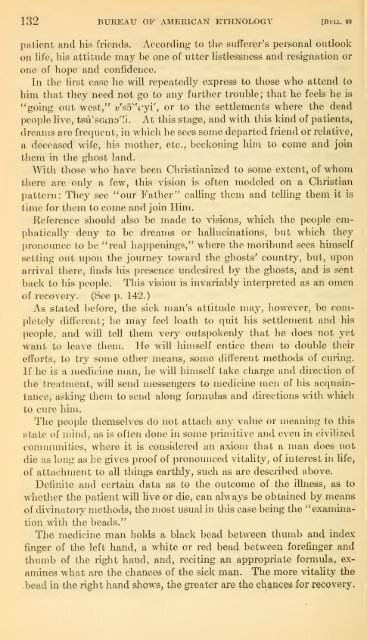Untitled - Smithsonian Institution
Untitled - Smithsonian Institution
Untitled - Smithsonian Institution
Create successful ePaper yourself
Turn your PDF publications into a flip-book with our unique Google optimized e-Paper software.
132 BUREAU OF AMERICAN ETHNOLOGY [Bull. 99<br />
patient and his friends. According to the sufferer's personal outlook<br />
on life, his attitude may be one of utter listlessness and resignation or<br />
one of hope and confidence.<br />
In the first case he will repeatedly express to those who attend to<br />
him that they need not go to any further trouble; that he feels he is<br />
"going out west," u'so'*fyi', or to the settlements where the dead<br />
people live, tsu'sGmo'!i. At this stage, and with this kind of patients,<br />
dreams are frecpient, in which he sees some departed friend or relative,<br />
a deceased wife, his mother, etc., beckoning him to come and join<br />
them in the ghost land.<br />
With those who have been Christianized to some extent, of whom<br />
there are only a few, this vision is often modeled on a Christian<br />
pattern: They see "our Father" calling them and telling them it is<br />
time for them to come and join Him.<br />
Reference should also be made to visions, which the people emphaticall}^<br />
deny to be dreams or hallucinations, but which they<br />
pronounce to be "real happenings," where the moribund sees himself<br />
setting out upon the journey toward the ghosts' country, but, upon<br />
arrival there, finds his presence undesired by the ghosts, and is sent<br />
back to his people. This vision is invariably interpreted as an omen<br />
of recovery. (See p. 142.)<br />
As stated before, the sick man's attitude may, however, be com-<br />
pletely different; he may feel loath to quit his settlement and his<br />
people, and will tell them very outspokenly that he does not yet<br />
want to leave them. He will liiiuself entice them to double their<br />
efforts, to try some other means, some difl"erent methods of curing.<br />
If he is a medicine man, he will himself take charge and direction of<br />
the treatment, will send messengers to medicine men of his acquaintance,<br />
asking them to send along formulas and directions wdth which<br />
to cure him.<br />
The people themselves do not attach any value or meaning to this<br />
state of mind, as is often done in some priiuitive and even in civilized<br />
communities, where it is considered an axiom that a man does not<br />
die as long as ho gives proof of pronounced vitality, of interest in life,<br />
of attachment to all things earthly, such as are described above.<br />
Definite and certain data as to the outcome of the illness, as to<br />
whether the patient will live or die, can always be obtained by means<br />
of divinatory methods, the most usual in this case being the "examina-<br />
tion vdth the beads."<br />
The medicine man holds a black bead between thumb and index<br />
finger of the left hand, a white or red bead between forefinger and<br />
thumb of the right hand, and, reciting an appropriate formula, examines<br />
what are the chances of the sick man. The more vitality the<br />
.bead in the right hand shows, the greater are the chances for recovery.

















